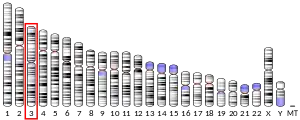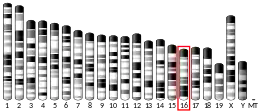GP5 (gene)
Glycoprotein V (platelet) (GP5) also known as CD42d (Cluster of Differentiation 42d), is a human gene.[5]
| GP5 | |||||||||||||||||||||||||
|---|---|---|---|---|---|---|---|---|---|---|---|---|---|---|---|---|---|---|---|---|---|---|---|---|---|
| Identifiers | |||||||||||||||||||||||||
| Aliases | GP5, CD42d, GPV, glycoprotein V platelet | ||||||||||||||||||||||||
| External IDs | OMIM: 173511 MGI: 1096363 HomoloGene: 74523 GeneCards: GP5 | ||||||||||||||||||||||||
| |||||||||||||||||||||||||
| |||||||||||||||||||||||||
| |||||||||||||||||||||||||
| |||||||||||||||||||||||||
| Orthologs | |||||||||||||||||||||||||
| Species | Human | Mouse | |||||||||||||||||||||||
| Entrez | |||||||||||||||||||||||||
| Ensembl | |||||||||||||||||||||||||
| UniProt | |||||||||||||||||||||||||
| RefSeq (mRNA) | |||||||||||||||||||||||||
| RefSeq (protein) | |||||||||||||||||||||||||
| Location (UCSC) | Chr 3: 194.39 – 194.4 Mb | Chr 16: 30.31 – 30.31 Mb | |||||||||||||||||||||||
| PubMed search | [3] | [4] | |||||||||||||||||||||||
| Wikidata | |||||||||||||||||||||||||
| |||||||||||||||||||||||||
Human platelet glycoprotein V (GP5) is a part of the Ib-V-IX system of surface glycoproteins that constitute the receptor for von Willebrand factor (VWF; MIM 193400) and mediate the adhesion of platelets to injured vascular surfaces in the arterial circulation, a critical initiating event in hemostasis. The main portion of the receptor is a heterodimer composed of 2 polypeptide chains, an alpha chain (GP1BA; MIM 606672) and a beta chain (GP1BB; MIM 138720), that are linked by disulfide bonds. The complete receptor complex includes noncovalent association of the alpha and beta subunits with platelet glycoprotein IX (GP9; MIM 173515) and GP5. Mutations in GP1BA, GP1BB, and GP9 have been shown to cause Bernard-Soulier syndrome (MIM 231200), a bleeding disorder.[supplied by OMIM][5]
See also
References
- GRCh38: Ensembl release 89: ENSG00000178732 - Ensembl, May 2017
- GRCm38: Ensembl release 89: ENSMUSG00000047953 - Ensembl, May 2017
- "Human PubMed Reference:". National Center for Biotechnology Information, U.S. National Library of Medicine.
- "Mouse PubMed Reference:". National Center for Biotechnology Information, U.S. National Library of Medicine.
- "Entrez Gene: GP5 glycoprotein V (platelet)".
Further reading
- Modderman PW, Admiraal LG, Sonnenberg A, von dem Borne AE (1992). "Glycoproteins V and Ib-IX form a noncovalent complex in the platelet membrane". J. Biol. Chem. 267 (1): 364–9. PMID 1730602.
- Shimomura T, Fujimura K, Maehama S, et al. (1990). "Rapid purification and characterization of human platelet glycoprotein V: the amino acid sequence contains leucine-rich repetitive modules as in glycoprotein Ib". Blood. 75 (12): 2349–56. doi:10.1182/blood.V75.12.2349.2349. PMID 2350580.
- Roth GJ, Church TA, McMullen BA, Williams SA (1990). "Human platelet glycoprotein V: a surface leucine-rich glycoprotein related to adhesion". Biochem. Biophys. Res. Commun. 170 (1): 153–61. doi:10.1016/0006-291X(90)91253-O. PMID 2372284.
- Hickey MJ, Hagen FS, Yagi M, Roth GJ (1993). "Human platelet glycoprotein V: characterization of the polypeptide and the related Ib-V-IX receptor system of adhesive, leucine-rich glycoproteins". Proc. Natl. Acad. Sci. U.S.A. 90 (18): 8327–31. Bibcode:1993PNAS...90.8327H. doi:10.1073/pnas.90.18.8327. PMC 47349. PMID 7690959.
- Meyer SC, Fox JE (1995). "Interaction of platelet glycoprotein V with glycoprotein Ib-IX regulates expression of the glycoproteins and binding of von Willebrand factor to glycoprotein Ib-IX in transfected cells". J. Biol. Chem. 270 (24): 14693–9. doi:10.1074/jbc.270.24.14693. PMID 7782333.
- Takafuta T, Fujimura K, Kawano H, et al. (1995). "Expression of platelet membrane glycoprotein V in human megakaryocytes and megakaryocytic cell lines: a study using a novel monoclonal antibody against GPV". Thromb. Haemost. 72 (5): 762–9. PMID 7900083.
- Lanza F, Morales M, de La Salle C, et al. (1993). "Cloning and characterization of the gene encoding the human platelet glycoprotein V. A member of the leucine-rich glycoprotein family cleaved during thrombin-induced platelet activation". J. Biol. Chem. 268 (28): 20801–7. PMID 8407908.
- Yagi M, Edelhoff S, Disteche CM, Roth GJ (1996). "Human platelet glycoproteins V and IX: mapping of two leucine-rich glycoprotein genes to chromosome 3 and analysis of structures". Biochemistry. 34 (49): 16132–7. doi:10.1021/bi00049a028. PMID 8519770.
- Berger G, Massé JM, Cramer EM (1996). "Alpha-granule membrane mirrors the platelet plasma membrane and contains the glycoproteins Ib, IX, and V." Blood. 87 (4): 1385–95. doi:10.1182/blood.V87.4.1385.bloodjournal8741385. PMID 8608228.
- Ravanat C, Morales M, Azorsa DO, et al. (1997). "Gene cloning of rat and mouse platelet glycoprotein V: identification of megakaryocyte-specific promoters and demonstration of functional thrombin cleavage". Blood. 89 (9): 3253–62. doi:10.1182/blood.V89.9.3253. PMID 9129030.
- Bradford HN, Dela Cadena RA, Kunapuli SP, et al. (1997). "Human kininogens regulate thrombin binding to platelets through the glycoprotein Ib-IX-V complex". Blood. 90 (4): 1508–15. doi:10.1182/blood.V90.4.1508. PMID 9269768.
- Wu G, Essex DW, Meloni FJ, et al. (1997). "Human endothelial cells in culture and in vivo express on their surface all four components of the glycoprotein Ib/IX/V complex". Blood. 90 (7): 2660–9. doi:10.1182/blood.V90.7.2660. PMID 9326233.
- Andrews RK, Harris SJ, McNally T, Berndt MC (1998). "Binding of purified 14-3-3 zeta signaling protein to discrete amino acid sequences within the cytoplasmic domain of the platelet membrane glycoprotein Ib-IX-V complex". Biochemistry. 37 (2): 638–47. doi:10.1021/bi970893g. PMID 9425086.
- Longhurst CM, White MM, Wilkinson DA, Jennings LK (1999). "A CD9, alphaIIbbeta3, integrin-associated protein, and GPIb/V/IX complex on the surface of human platelets is influenced by alphaIIbbeta3 conformational states". Eur. J. Biochem. 263 (1): 104–11. doi:10.1046/j.1432-1327.1999.00467.x. PMID 10429193.
- Dicker IB, Pedicord DL, Seiffert DA, et al. (2002). "Both the high affinity thrombin receptor (GPIb-IX-V) and GPIIb/IIIa are implicated in expression of thrombin-induced platelet procoagulant activity". Thromb. Haemost. 86 (4): 1065–9. PMID 11686325.
- Rabie T, Strehl A, Ludwig A, Nieswandt B (2005). "Evidence for a role of ADAM17 (TACE) in the regulation of platelet glycoprotein V." J. Biol. Chem. 280 (15): 14462–8. doi:10.1074/jbc.M500041200. PMID 15691827.
- Aktas B, Pozgajova M, Bergmeier W, et al. (2006). "Aspirin induces platelet receptor shedding via ADAM17 (TACE)". J. Biol. Chem. 280 (48): 39716–22. doi:10.1074/jbc.M507762200. PMID 16179345.
- Lewandrowski U, Moebius J, Walter U, Sickmann A (2006). "Elucidation of N-glycosylation sites on human platelet proteins: a glycoproteomic approach" (PDF). Mol. Cell. Proteomics. 5 (2): 226–33. doi:10.1074/mcp.M500324-MCP200. PMID 16263699. S2CID 7856143.
External links
- GP5+protein,+human at the US National Library of Medicine Medical Subject Headings (MeSH)
This article incorporates text from the United States National Library of Medicine, which is in the public domain.




